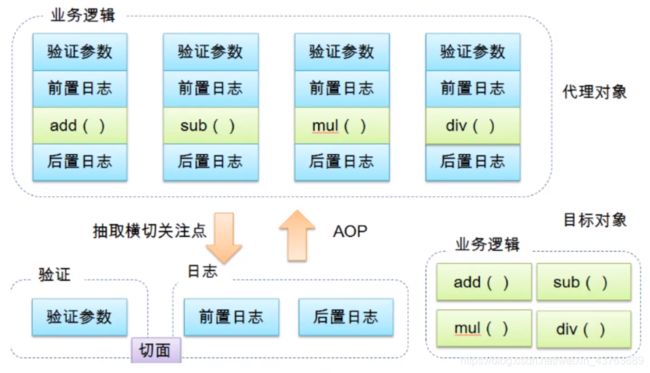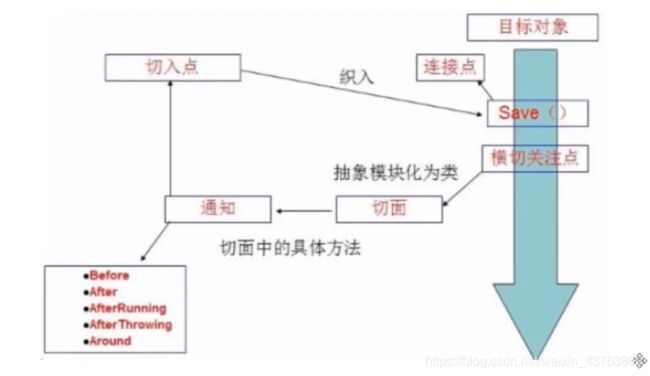Spring学习笔记(三)——代理模式和AOP
文章目录
- 六、代理模式
- 6.1 静态代理模式
- 6.2 动态代理模式
- 七、AOP
- 7.1 什么是AOP
- 7.2 核心概念
- 7.3 Spring实现AOP
- 7.4 注解实现AOP
六、代理模式
SpringAOP的底层
6.1 静态代理模式
角色分析:
- 抽象角色:一般会使用接口或者抽象类来解决
- 真实角色:被代理的角色(房东)
- 代理角色:代理真实角色,做一些附属操作(中介)
- 客户:访问代理角色的人(租客)
静态代理的好处:
- 可以使真实角色的操作更纯粹,不用去关注一些公共的事务
- 实现了业务的分工
- 公共业务发生扩展时,方面集中处理
缺点:一个真是角色就会产生一个代理角色,代码量翻倍,开发效率低
6.2 动态代理模式
rent接口
public interface Rent {
public void rent();
}
Host类
public class Host implements Rent{
public void rent() {
System.out.println("房东出租房子");
}
}
import java.lang.reflect.InvocationHandler;
import java.lang.reflect.Method;
import java.lang.reflect.Proxy;
//这个类用于自动生成代理类
public class ProxyInvocationHandler implements InvocationHandler {
//被代理的接口
private Object target;
public void setTarget(Object target) {
this.target = target;
}
//生成得到代理类
public Object getProxy(){
return Proxy.newProxyInstance(this.getClass().getClassLoader(), target.getClass().getInterfaces(), this);
}
//处理代理实例,并返回结果
//当调用代理代理对象的方法时,
public Object invoke(Object proxy, Method method, Object[] args) throws Throwable {
Object invoke = method.invoke(target, args);
return invoke;
}
}
客户类
public class Client {
public static void main(String[] args) {
//真实对象
Host host = new Host();
//代理对象
ProxyInvocationHandler pih = new ProxyInvocationHandler();
//设置要代理的对象
pih.setTarget(host);
//获得代理
Rent proxy = (Rent)pih.getProxy();
proxy.rent();
}
}
动态代理的好处:
- 可以使真实角色的操作更加纯粹
- 公共业务交给了代理角色
- 方便扩展公共业务
- 一个动态代理类对应的是一个接口,一般就是对应的一类业务
- 一个动态代理类可以代理多个类,只要实现了同一个接口
七、AOP
7.1 什么是AOP
AOP,英文全称Aspect Oriented Propramming ,以为面向切面编程
AOP在Spring中的作用:提供生命式事务;允许用户自定义切面
7.2 核心概念
-
横切关注点:对哪些方法进行拦截,拦截后怎么处理,这些关注点称之为横切关注点
-
切面(aspect):类是对物体特征的抽象,切面就是对横切关注点的抽象
-
连接点(joinpoint):被拦截到的点,因为Spring只支持方法类型的连接点,所以在Spring中连接点指的就是被拦截到的方法,实际上连接点还可以是字段或者构造器
-
切入点(pointcut):对连接点进行拦截的定义
-
通知(advice):所谓通知指的就是指拦截到连接点之后要执行的代码,通知分为前置、后置、异常、最终、环绕通知五类
-
目标对象:代理的目标对象,被通知对象
-
织入(weave):将切面应用到目标对象并导致代理对象创建的过程
-
引入(introduction):在不修改代码的前提下,引入可以在运行期为类动态地添加一些方法或字段
7.3 Spring实现AOP
依赖
<dependency>
<groupId>org.aspectjgroupId>
<artifactId>aspectjweaverartifactId>
<version>1.9.4version>
dependency>
UserService接口
public interface UserService {
public void add();
public void delete();
public void update();
public void query();
}
UserServiceImp类
public class UserServiceImp implements UserService{
public void add() {
System.out.println("增加一个用户");
}
public void delete() {
System.out.println("删除一个用户");
}
public void update() {
System.out.println("修改一个用户");
}
public void query() {
System.out.println("查询一个用户");
}
}
前置方法 继承MethodBeforeAdvice接口,实现before函数
package Log;
import org.springframework.aop.MethodBeforeAdvice;
import java.lang.reflect.Method;
public class BeforeLog implements MethodBeforeAdvice {
/*
method:要执行的目标对象的方法
args:参数
target:目标对象
*/
public void before(Method method, Object[] args, Object target) throws Throwable {
System.out.println("执行" + target.getClass().getName() + "的" + method.getName());
}
}
后置方法
package Log;
import org.springframework.aop.AfterReturningAdvice;
import java.lang.reflect.Method;
public class AfterLog implements AfterReturningAdvice {
//returnValue 返回值
public void afterReturning(Object returnValue, Method method, Object[] args, Object target) throws Throwable {
System.out.println("成功执行了" + method.getName() + "方法,返回结果为" + returnValue);
}
}
第一种方式:
<beans xmlns="http://www.springframework.org/schema/beans"
xmlns:xsi="http://www.w3.org/2001/XMLSchema-instance"
xmlns:aop="http://www.springframework.org/schema/aop"
xsi:schemaLocation="http://www.springframework.org/schema/beans
https://www.springframework.org/schema/beans/spring-beans.xsd
http://www.springframework.org/schema/aop https://www.springframework.org/schema/aop/spring-aop.xsd">
<bean id="userService" class="UserServiceImp"/>
<bean id="beforeLog" class="Log.BeforeLog"/>
<bean id="afterLog" class="Log.AfterLog"/>
方式一:使用原生Spring API接口
<aop:config>
<aop:pointcut id="log" expression="execution(* UserServiceImp.*(..))"/>
<aop:advisor advice-ref="beforeLog" pointcut-ref="log"/>
<aop:advisor advice-ref="afterLog" pointcut-ref="log"/>
aop:config>
beans>
execution(<修饰符模式>?<返回类型模式><方法名模式>(<参数模式>)<异常模式>?) 除了返回类型模式、方法名模式和参数模式外,其它项都是可选的。
execution()是最常用的切点函数,其语法如下所示:
整个表达式可以分为五个部分:
1、execution(): 表达式主体。
2、第一个*号:表示返回类型,*号表示所有的类型。
3、包名:表示需要拦截的包名,后面的两个句点表示当前包和当前包的所有子包,com.sample.service.impl包、子孙包下所有类的方法。
4、第二个*号:表示类名,*号表示所有的类。
5、*(…):最后这个星号表示方法名,*号表示所有的方法,后面括弧里面表示方法的参数,两个句点表示任何参数。
execution(* UserServiceImp.*(…))
- 第一个* 代表可以返回任意类型
- 第二个参数是包名
- .*表示当前包下的所有方法
- (…)代表任意参数
第二种方式
<bean id="cutPoint" class="PointCut"/>
<aop:config>
<aop:aspect ref="cutPoint">
<aop:pointcut id="point" expression="execution(* UserService.*(..))"/>
<aop:before method="before" pointcut-ref="point"/>
<aop:after method="after" pointcut-ref="point"/>
aop:aspect>
aop:config>
测试
import org.junit.Test;
import org.springframework.context.ApplicationContext;
import org.springframework.context.support.ClassPathXmlApplicationContext;
public class Mytest {
@Test
public void test(){
ApplicationContext context = new ClassPathXmlApplicationContext("applicationContext.xml");
//动态代理代理的是接口
UserService userService = (UserService) context.getBean("userService");
userService.delete();
}
}
7.4 注解实现AOP
import org.aspectj.lang.ProceedingJoinPoint;
import org.aspectj.lang.annotation.After;
import org.aspectj.lang.annotation.Around;
import org.aspectj.lang.annotation.Aspect;
import org.aspectj.lang.annotation.Before;
@Aspect //切面
public class AnnotationPointCut {
@Before("execution(* UserServiceImp.*(..))")
public void before(){
System.out.println("方法执行前");
}
@After("execution(* UserServiceImp.*(..))")
public void after(){
System.out.println("方法执行后");
}
@Around("execution(* UserServiceImp.*(..))")
public void around(ProceedingJoinPoint proceedingJoinPoint) throws Throwable {
System.out.println("环绕前");
Object proceed = proceedingJoinPoint.proceed();//执行方法
System.out.println("环绕后");
System.out.println(proceed);
}
}
配置
<bean id="annotation" class="AnnotationPointCut"/>
<aop:aspectj-autoproxy/>




